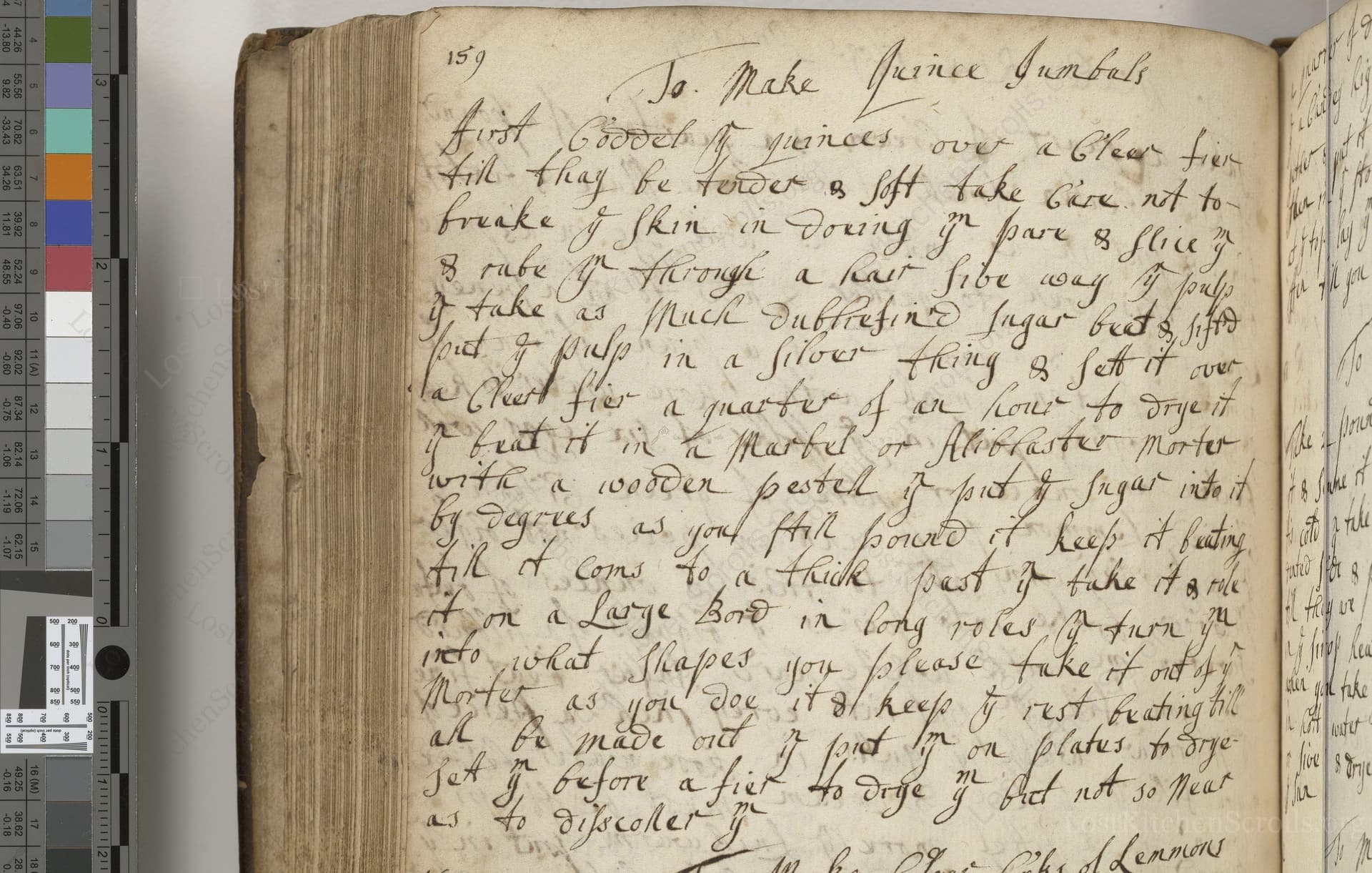To Make Quince Jumballs
From the treasured pages of Receipt book
Unknown Author

To Make Quince Jumballs
"first Coddel yr quinces over a Clear fier till thay be tender & soft take Care not to breake ye skin in doeing it pare & slice ym & rube it through a hair sive then take as Much Dublefind sugar best & sifted put ye pulp in a silver thing & sett it over a Clear fier a quarter of an hour to drye it beat it in a Marbel or Aliblaster Morter with a wooden pestel & put ye sugar into it by degrees as you still pound it keep it beating till it coms to a thick past & take it & role it on a large Bord in long roles & turn ym into what shapes you please take it out of ye Morter as you doe it & keep it rest beating till all be made out & put ym on plates to drye sett ym before a fier to drye ym but not so near as to discolor ym"
Note on the Original Text
The recipe is characteristic of its time—written for experienced cooks familiar with the nuances of technique, with little to no attention to precise quantities, times, or temperatures. The spellings ('coddle', 'ym', 'Aliblaster', etc.) reflect fluid 18th-century English, phonetic variants, and a playful approach to orthography. Instructions are delivered in a stream-of-consciousness manner, anticipating that the reader can interpret and adapt as needed, as was the custom in such manuscript collections.

Title
Receipt book (1700)
You can also click the book image above to peruse the original tome
Writer
Unknown
Era
1700
Publisher
Unknown
Background
Step back into the bustling kitchens of the 18th century, where this delightful collection offers a taste of bygone feasts, whimsical recipes, and the art of refined entertaining.
Kindly made available by
Folger Shakespeare Library
This recipe for Quince Jumballs hails from early 18th-century England, a time when jellied and candied fruits were beloved delicacies for the well-to-do. Jumballs—likely a corruption of 'jumble,' meaning a sort of sweetmeat or confection—were enjoyed as both edible art and genteel table fare. The recipe is sourced from a household manuscript ('V.a.685'), a common method of recipe sharing in the period, before printed cookbooks became widespread. The lavish use of quinces and double-refined sugar signals a genteel kitchen, as both were precious commodities.

Traditional kitchen tools for this recipe would have included a silver pan or saucepan for gently drying the fruit paste, a hair sieve for straining the pulp, a marble or alabaster mortar and a wooden pestle for pounding the paste, and wooden boards for rolling and shaping. Plates and hearths or firesides provided the gentle heat needed to dry and set the jumballs without discoloring their delicate color.
Prep Time
30 mins
Cook Time
35 mins
Servings
24
We've done our best to adapt this historical recipe for modern kitchens, but some details may still need refinement. We warmly welcome feedback from fellow cooks and culinary historians — your insights support the entire community!
Ingredients
- 2.2 lbs quinces (or substitute a mix of firm apples and pears if quinces unavailable)
- 2.2 lbs double-refined (superfine) white sugar
- Water (enough to coddle/simmer quinces)
Instructions
- Begin by gently simmering quinces (about 2.2 lbs) in water over a low to medium heat until they are tender, being careful not to break their skins.
- Once soft, peel and slice the quinces, then pass the fruit through a fine sieve or food mill to create a smooth pulp.
- Weigh the quince pulp and measure an equal weight of the finest white sugar (about 2.2 lbs).
- Place the pulp in a heavy-bottomed saucepan (traditionally silver, but stainless steel is perfect) and cook over low heat for 15 minutes, stirring constantly to begin drying it out.
- Transfer the pulp to a marble or porcelain mortar and pound with a wooden pestle, gradually adding the sugar until fully incorporated and the mixture forms a thick, smooth paste.
- Roll the paste on a clean board into long ropes, then shape as desired.
- Lay the shaped jumballs on parchment-lined trays and leave them to dry near gentle heat, such as an oven with just the light on or on a radiator, but never so close as to discolor them.
- Allow to dry for several hours—or overnight—until firm and easy to handle.
Estimated Calories
80 per serving
Cooking Estimates
It takes about 15 minutes to cook the quinces until soft, plus another 15-20 minutes to cook and dry the pulp. Prep involves peeling, slicing, sieving, and shaping, which takes about 30 minutes. The jumballs need at least 6 hours to dry until firm. Each piece is a sweet treat and contains about 80 calories; this recipe makes about 24 pieces.
As noted above, we have made our best effort to translate and adapt this historical recipe for modern kitchens, taking into account ingredients nowadays, cooking techniques, measurements, and so on. However, historical recipes often contain assumptions that require interpretation.
We'd love for anyone to help improve these adaptations. Community contributions are highly welcome. If you have suggestions, corrections, or cooking tips based on your experience with this recipe, please share them below.
Join the Discussion
Rate This Recipe
Dietary Preference
Main Ingredients

Den Bockfisch In Einer Fleisch Suppen Zu Kochen
This recipe hails from a German manuscript cookbook compiled in 1696, a time whe...

Die Grieß Nudlen Zumachen
This recipe comes from a rather mysterious manuscript cookbook, penned anonymous...

Ein Boudain
This recipe comes from an anonymous German-language manuscript cookbook from 169...

Ein Gesaltzen Citroni
This recipe, dating from 1696, comes from an extensive anonymous German cookbook...
Browse our complete collection of time-honored recipes



